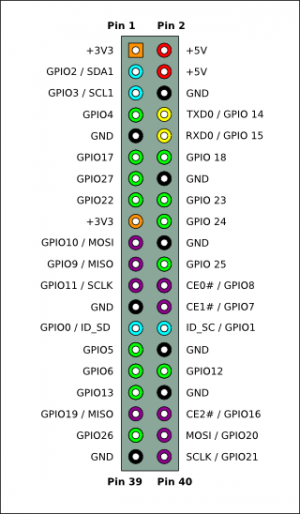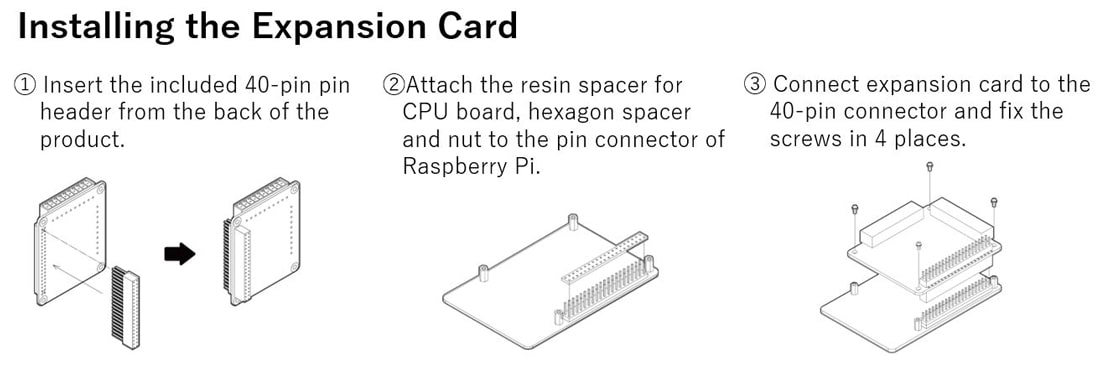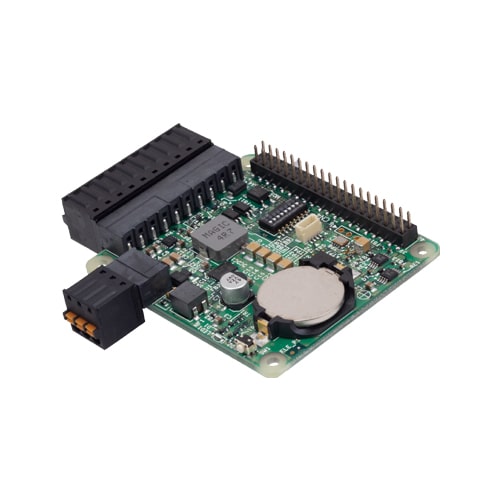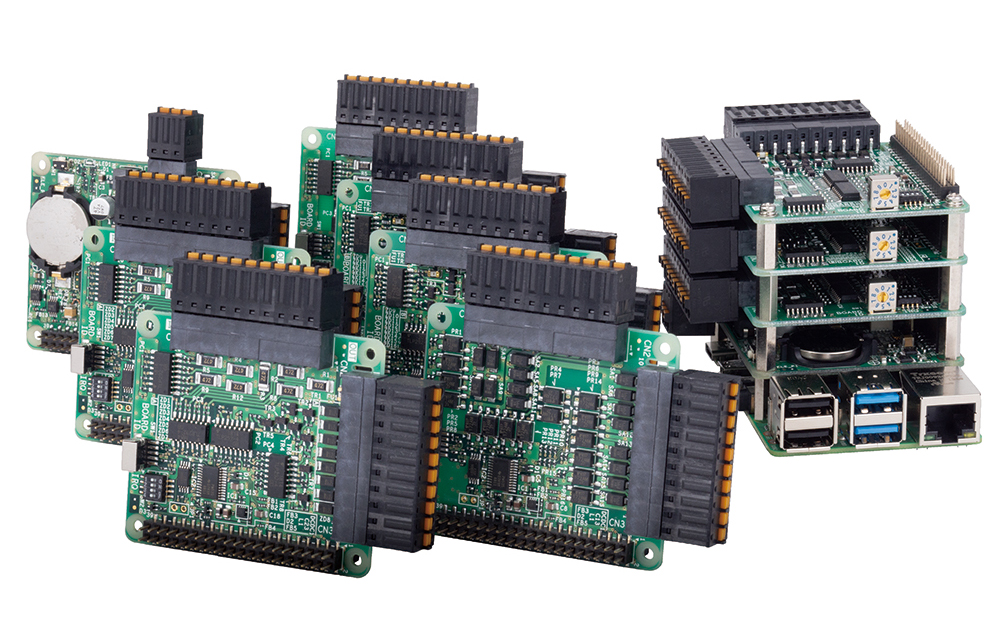In April 2021, Contec began sales of a Raspberry Pi compatible HAT-size expansion card based on the theme of “Raspberry Pi Support for Ease of Use in FA and Measurement Control Applications.” This blog will introduce the concept and expected applications of Contec Raspberry Pi expansion cards.
Contents
History of PC Measurement Control Interface Cards
The history of Japanese personal computers (hereinafter “PCs”) started with the PC-8001 that was released by NEC in 1979. In 1982, Contec began the development and sales of an interface card that could be used with the PC-8012 I/O unit of the NEC PC-8001 and also with the PC-8801. Subsequently NEC released the PC-9801 equipped with a 16-bit CPU. Over the years, the environment surrounding PCs has changed significantly, from IBM PC-compatible PCs (DOS/V) becoming the standard overseas followed by wider use in Japan, to the introduction of Windows, which allowed a PC to be operated via a graphical UI.
| Year |
What happened |
|
1979
|
- NEC released the PC-8001 personal computer equipped with an 8-bit CPU.This marked the start of the history of personal computers in Japan.
|
|
1982
|
- Contec released an interface card for the PC-8012 I/O unit of the NEC PC-8001 and for the PC-8801.
- NEC released the PC-9801 personal computer equipped with a 16-bit CPU.
|
|
1988年
|
- Contec released an interface card for the NEC PC-9801.
|
|
1990
|
- IBM Japan released a Japanese-language OS “DOS/V” that operated on PC/AT-compatible machines.
|
|
1991年
|
- Microsoft established a company in Japan.
|
Under the motto “Bringing the ease of PCs to FA,” Contec PC interface cards contributed to the advancement of PC use in industrial applications as the company developed and sold a wide range of the interface cards that were needed by PCs, and provided support for expansion buses with continually improving levels of performance.
In addition to CPU developed for Intel, AMD, and other PCs, microcomputers which utilize ARM architecture are now rapidly being adopted for use in industry, education, logistics, communications, and other fields. Raspberry Pi can be described as a PC that utilizes ARM architecture. It is attracting growing interest for its use in industrial applications, and is expanding as the new de facto standard. Contec has a history of providing products that can easily be used for FA by anybody, and is also developing and selling expansion cards for Raspberry Pi in the same way. In the future, it intends to continue providing products that allow Raspberry Pi to be easily used for industrial applications.
Raspberry Pi Also in the Spotlight for Industrial Applications

When Raspberry Pi was released in 2012, it was expected to be used in educational applications. However now nearly 10 years since its initial release, Raspberry Pi has evolved to its fourth generation while still maintaining the same base concept. Throughout its history, Raspberry Pi has birthed a large number of peripheral devices and applications that go beyond the field of education, and is continuing to gain in recognition as a platform that allows convenient program development.
The “Raspberry Pi Compute Module” was released to meet the demand for embedded industrial applications, and the number of companies using the Raspberry Pi platform in industrial applications is growing. The Raspberry Pi Foundation announced that as of June 2018, 60% of monthly device production was for industrial applications.
Advantages When Using Raspberry Pi for Industrial Applications
The advantages of using Raspberry Pi for industrial applications are explained below.
Abundant supply of information available on the Internet for using a wide range of interfaces
People tend to think that the number one reason why users consider Raspberry Pi is its low price. However in fact, when companies consider using Raspberry Pi for their own products, even more than the low price, the greatest advantages are the large number of peripheral devices and the resulting abundant supply of information that is available on the Internet and is useful when using a wide range of interfaces.
When adopting a controller for a company’s products or using one in improvement activities at a company factory, a large number of man-hours is required to collect the information which is needed to create the programs and develop the software that will operate on the controller. This involves large costs.
When Raspberry Pi is used, it is possible to easily obtain information for a wide range of needs such as using a particular sensor, communicating with a peripheral device, or connecting to a cloud service. In the world of Raspberry Pi, because not all information is certain to be trustworthy, it is necessary to investigate and verify. However the large volume of reference information that is available presents large advantages for software development.
Ability to use Linux assets, which can be used in an extensive range of software assets
The primary approach to conventional software development utilizes a waterfall method. First the overall basic design and schedule are decided, and then development and installation are carried out based on this plan. Even now, this approach is used for large-scale system development and the creation of software that requires high reliability. However recently it has become necessary to shorten development periods and develop software with high degrees of novelty. For this purpose, much attention has been given to agile development, which is capable of reducing development periods compared to conventional development methods.
With agile development, development is carried out without deciding the precise specifications at the release planning stage. There is a large focus on communication among members, and the method allows flexible implementation of specification changes and additions during the development process.
When using this kind of development method as well, the Raspberry Pi development environment allows smooth progress from prototype verification to actual operation. This is thanks to its ability to use Linux assets, which can be used in an extensive range of software assets, and also to the easy availability of case studies for connections to a large number of peripheral devices.
Disadvantages When Using Raspberry Pi for Industrial Applications
Inadequate capacity of the power supply from the USB port and unstable operation related to SD card reliability
However Raspberry Pi does have disadvantages when used for industrial applications. These include the inadequate capacity of the power supply from the USB port and unstable operation related to SD card reliability.
Regarding the power supply, this is not a large problem when only a single Raspberry Pi card is used. However the power supply may be inadequate when connecting peripheral devices using USB, or for expanded connections of display devices or I/O cards. When using Raspberry Pi for industrial applications, it is necessary to consider the total power consumption.
Regarding SD card reliability, it is impossible to eliminate the possibility of events such as problems with the number of silicon disc rewrites, SD card failures, and loss of measurement data. It is recommended that steps be taken to reduce this risk, such as by using SD cards that were produced specifically for industrial applications, and by saving measurement data on cloud or network storage instead of writing data to SD cards during the system design phase.
No backup of the internal calendar clock
As Raspberry Pi was designed specifically for educational applications, there is no backup of the internal calendar clock. (The date and time are erased when the power is turned OFF.) This is not a large problem in an environment where Raspberry Pi is continually connected to a network and synchronization with a time server is possible. However network connections are not possible in many of the applications which are embedded into a system or device. Because there are operations which require a managed calendar or clock to operate, it is necessary to consider a countermeasure during system design.
Function Expansion
The methods of expanding Raspberry Pi functions include the same LAN port and USB interface as an ordinary PC, and also include expansion by means of a board stack connection using a 40-pin pin header called HAT (Hardware Attached on Top). The specifications released by the Raspberry Pi Foundation prescribe the card physical layout, producer information, the GPIO settings needed for Linux to correctly recognize the pins when connecting to an expanded port, and information related to the on-board I2C EEPROM memory which contains a part of the device tree.
The pin header contains signals that are necessary for expansion such as GPIO, UART, I2C, SPI, I2S, and PWM.


*
From the
Raspberry Pi HP
Red 5v, orange 3.3v, black GND, white Advanced use only

With the Raspberry Pi standard OS “Raspbian,” the “gpio” command can be used to acquire the GPIO settings and status. In addition, a Python package called “RPi.GPIO” is also available, and can be easily executed from the script language Python or PHP.
The procedure when installing an expansion card is shown below.

Approach to Industrial Applications
Contec has begun selling expansion interfaces (CPI Series) that are compatible with Raspberry Pi.
The CPI Series includes the following improvements which allow Raspberry Pi to be used reliably in industrial applications.
Countermeasure to inadequate power supply capacity
As explained before, the power supply from the Raspberry Pi USB port is inadequate when peripheral devices or expansion cards are connected. Based on its experience delivering numerous products for industrial fields, Contec understood that it was necessary for Raspberry Pi to be able to supply power from a 12 to 24 V DC power source. The RAS/RTC cards (CPI-RAS) include a power connector that can supply DC power as the power source for operating Raspberry Pi, and is able to supply voltage in a wide range from 8 to 28 V DC. The power circuit includes a high-output, high-efficiency 5 V DC, 5 A power supply and a noise filter for removing external noise, and supplies clean power to the Raspberry Pi CPU card. As a result, when multiple peripheral devices or expansion cards are installed, it is still possible to provide a stable supply of power even when installed on a moving object that operates on battery power.
Measures for stable program operation
When using Raspberry Pi for industrial applications, software with a high degree of perfection is necessary. However there are cases when the program stops for some reason or a malfunction occurs under unexpected circumstances. A system mechanism is needed for safe stopping and automatic restarting when this kind of software problem occurs. The RAS/RTC cards (CPI-RAS) include an internal watchdog timer (WDT) function. In the event of a CPU runaway or other unexpected program operation, it is possible to use hardware means to reboot the CPU.
Because Raspberry Pi was designed for educational applications, some users may be concerned about instability related to the operating temperature.
The RAS/RTC cards (CPI-RAS) can utilize the functions of an installed microcomputer chip to measure the RAS/RTC card temperature. This makes it possible to monitor changes in the ambient temperature around Raspberry Pi, and can be used as a guideline for measures to improve the ambient temperature environment such as installing ventilation fans or cooling equipment.
Functions for industrial applications
When constructing an industrial application system, in most cases accurate time management is required.
The time function (RTC) installed in the Raspberry Pi does not have a battery backup function. With a RTC that includes temperature compensation, time will generally be accurate at an environmental temperature of around 25°C. However in low- or high-temperature environments, accuracy is likely to decrease due to the characteristics of the internal crystal. The RAS/RTC cards (CPI-RAS) include a RTC with temperature compensation that enables battery backup and performs time correction according to the temperature environment in order to improve the accuracy of time tracking.
Because intermittent operation by timer interrupt is also supported, use is also possible with applications that want to start Raspberry Pi at a specified time. The included low power consumption power supply circuit also minimizes current consumption during shutdown.
In order to provide Raspberry Pi with power switch functions, the RAS/RTC cards (CPI-RAS) can operate the power supply based on digital input from the power switch and interface connector. The power switch can also be long-pressed to forcibly turn off the power, providing convenient functions for use in embedded applications.
Providing a convenient software development environment
To allow convenient use of the Contec expansion cards which can be used with Raspberry Pi, RAS/RTC card drivers and digital I/O drivers are provided. Function groups are provided that consider compatibility with Windows API-PAC/API-TOOL so that customers who used Windows in the past to develop applications for Contec instrumentation cards can feel right at home and can easily perform development using Raspberry Pi.
Features of RAS/RTC Raspberry Pi card(CPI-RAS)
This product is RAS function expansion card for even greater Raspberry Pi functionality. The 40-pin GPIO pin header connector of a Raspberry Pi computer can be used for adding functionality through stacked connections to HAT (Hardware Attached on Top) size expansion cards and the card adds industrial computer availability and maintainability to the Raspberry Pi.
-
RAS function expansion card for even greater Raspberry Pi functionality
- The included 8 to 28 VDC power supply function makes it possible to use Raspberry Pi in a wide range of power supply environments.
-
Push-type terminal block for easy wiring
- The CPI Series includes a push-type terminal block for convenient, simple connection and disconnection of wired HATs without the need for tools or crimping terminals.
-
Equipped battery switching function
- Battery switching function that commercial PC has can be added to Raspberry Pi and it also supports forced power-off function by doing a long press. The operation can be performed from the digital input of the push switch or external expansion connector installed in this product.
-
Equipped Real Time Clock (RTC) to temperature compensation
- The RTC temperature compensation, and the time can be accurately corrected according to the temperature environment. In addition, it supports intermittent operation by timer interrupt, and it is possible to start Raspberry Pi at the specified date and time by setting the start date and time.

Features of digital I/O raspberry Pi cards
The digital I/O cards are expansion cards that adds photocoupler-insulated digital I/O to the Raspberry Pi.
The 40-pin GPIO pin header connector of a Raspberry Pi computer can be used for adding functionality through stacked connections to HAT (Hardware Attached on Top) size expansion cards and the card adds industrial computer availability to the Raspberry Pi.

-
Push-type terminal block for easy wiring
- The CPI Series includes a push-type terminal block for convenient, simple connection and disconnection of wired HATs without the need for tools or crimping terminals.
-
Stacked connection of up to 8 cards
- CONTEC has expanded HAT specifications to include address ID configurability, making it possible to connect up to eight stacked cards.
* Connection to HATs from other manufacturers is also possible.
-
API compatible with PC expansion cards and Python-compatible API
- Take advantage of API compatibility with CONTEC PCI Express, PCI, USB, and Ethernet-type measurement control devices. Development assets can be reused across multiple platforms. Linux driver (API-TOOL for Linux) can be downloaded for free from the company’s website along with sample Python and GCC programs, allowing users to begin programming right away.
-
Offers a wide variety of input / output types
- 16ch input / 16ch output / 8ch I/O can be used for current sink type, open collector, and source output. A 16ch Solid-state relay output is also available.
The drive voltage is compatible with 12-24VDC for both input and output.
-
Opto-coupler bus isolation
- By opto-coupler, GPIO 40-pin connector of Raspberry Pi is isolated from the input and output interfaces to achieve excellent noise resistance.
*CPI-RRY-16 has a bus insulation specification using photo MOS.
-
Adaptable to a temperature range between -20 to 60°C
- The product is capable of operating in the temperature between -20 to 60°C. It can be installed in the various environments.
Future Plans
At present, the only Contec expansion card for Raspberry Pi is a digital I/O card, however the company is planning to actively develop and sell products that can support the use of Raspberry Pi for industrial applications in the future. Such products will include analog I/O, RS-232/RS-422 and other communication cards, and cards for special applications.
Backed by the availability of inexpensive hardware and a highly convenient development environment, the use of Raspberry Pi in industrial applications is expected to grow steadily in fields where high reliability and high performance are required. Just as the personal computers that were thought to be for hobby use when Contec was founded eventually became indispensable in industrial fields, in several years Raspberry Pi may also be essential for factory equipment and embedded systems.
“PC For All Automation.” Based on this universal principle, Contec will continue to develop new products and propose new methods of use in order to become a company which drives the use of Raspberry Pi in industrial applications.
Related Links
See All Blogs